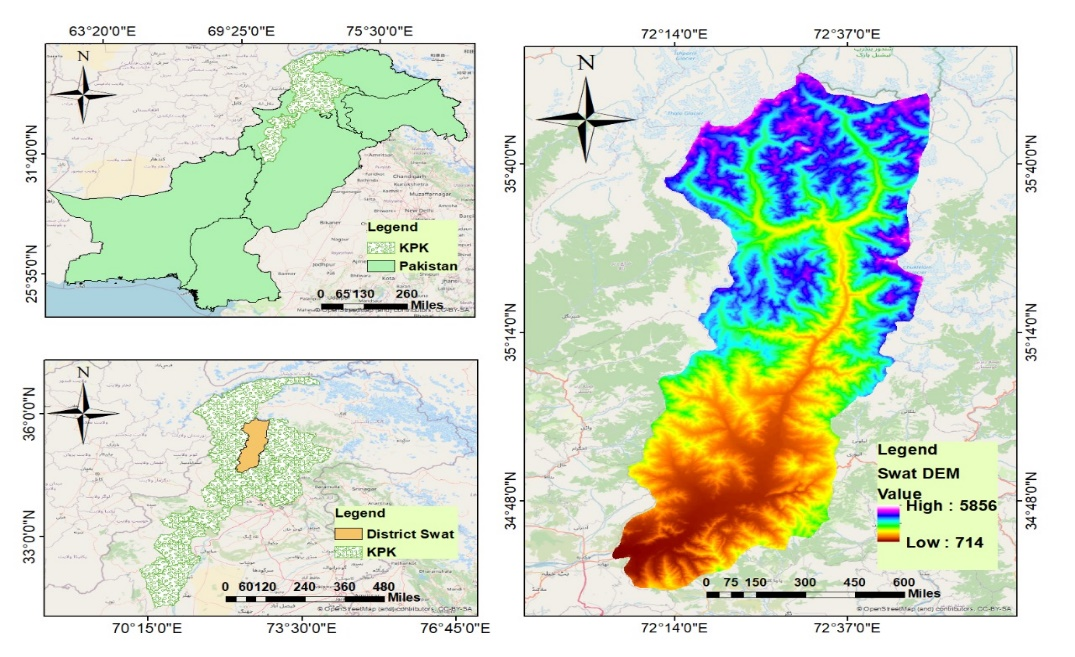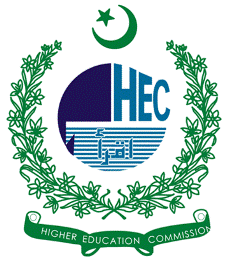Evaluating the Meteorological Pattern of District Swat Using Different SSP Scenarios
Keywords:
Climate Change, GCM, Anomalies, SSPs, IDF, Machine LearningAbstract
This study investigates the observed and projected impacts of climate change in District Swat, Pakistan, using meteorological records and CMIP6-based projections under SSP2-4.5 and SSP5-8.5 scenarios. Metrological variables, such as temperature and precipitation, were examined for long-term trends, anomalies, and extremes. Machine learning techniques (XGBoost and SHAP) were used to identify the most relevant online datasets and climate models. ERA5 emerged as the most reliable online source, and INM-CM5-0, CNRM-CM6-1, and CMCC-ESM2 were selected as the best-performing GCMs. The Mann-Kendall test showed a significant rise in minimum and maximum temperatures based on future conditions. For instance, the maximum temperature under SSP5-8.5 had a significant increasing trend with a Kendall Tau value of 0.1517, a Sen Slope of 0.00018, and a p-value less than 0.001. In the meantime, the trend of precipitation under SSP2-4.5 was decreasing significantly, which indicated the likelihood of an even more arid future. Under SSP5-8.5, temperature anomalies might be as high as 6.5°C, and precipitation anomalies could be as low as -1.5 mm or as high as +2 mm. Furthermore, Intensity-Duration-Frequency (IDF) analysis indicated that extreme rainfall events are projected to intensify, with rainfall intensities for the 100-year return period increasing from an observed value of 340 mm/hr to 360 mm/hr under SSP5-8.5. These outcomes show a potential rising trend of warmer and possibly drier conditions in the Swat District, and higher vulnerability to severe weather conditions. The results show that we need infrastructure that can handle climate change, flexible water management plans, and aggressive planning to lessen the effects of future extreme weather events.
References
“Prediction of Discharge Using Artificial Neural Network and IHACRES Models Due to Climate Change,” J. Renew. Energy Environ., vol. 8, no. 3, pp. 75–85, 2021, Accessed: Jul. 28, 2025. [Online]. Available: https://www.magiran.com/paper/2305515/prediction-of-discharge-using-artificial-neural-network-and-ihacres-models-due-to-climate-change?lang=en
A. B. S. & M. F. P. B. Walter W. Immerzeel, L. P. H. van Beek, M. Konz, “Hydrological response to climate change in a glacierized catchment in the Himalayas,” Clim. Change, vol. 110, pp. 721–736, 2012, [Online]. Available: https://link.springer.com/article/10.1007/s10584-011-0143-4
P. Friedlingstein et al., “Update on CO2 emissions,” Nat. Geosci., vol. 3, no. 12, pp. 811–812, Dec. 2010, doi: 10.1038/NGEO1022;SUBJMETA=106,169,172,704,824;KWRD=ATMOSPHERIC+CHEMISTRY,CLIMATE+SCIENCES.
J. P. Eylon Shamir, Sharon B. Megdal, Carlos Carrillo, Christopher L. Castro, Hsin-I Chang, Karletta Chief, Frank E. Corkhill, Susanna Eden, Konstantine P. Georgakakos a, Keith M. Nelson, “Erratum to ‘Climate change and water resources management in the Upper Santa Cruz River, Arizona’ [J. Hydrol. 521 (2015) 18–33],” J. Hydrol., vol. 257, p. 1190, 2015, doi: https://doi.org/10.1016/j.jhydrol.2015.04.067.
G. K.-B. Tamiru Paulos Orkodjo, “Impact of climate change on future precipitation amounts, seasonal distribution, and streamflow in the Omo-Gibe basin, Ethiopia,” Heliyon, vol. 8, no. 6, p. e09711, 2022, [Online]. Available: https://www.cell.com/heliyon/fulltext/S2405-8440(22)00999-9?_returnURL=https%3A%2F%2Flinkinghub.elsevier.com%2Fretrieve%2Fpii%2FS2405844022009999%3Fshowall%3Dtrue
A. H. Md. Rabiul Islam, Md. Tareq Aziz, H. M. Imran, “HEC-HMS-based future streamflow simulation in the Dhaka River Basin under CMIP6 climatologic projections,” Res. Sq., 2024, [Online]. Available: https://www.researchsquare.com/article/rs-4519681/v1
F. G. Matilde García-Valdecasas Ojeda, Fabio Di Sante, Erika Coppola, Adriano Fantini, Rita Nogherotto, Francesca Raffaele, “Climate change impact on flood hazard over Italy,” J. Hydrol., vol. 615, p. 128628, 2022, doi: https://doi.org/10.1016/j.jhydrol.2022.128628.
H. W. Muhammad Adnan, Baohua Xiao, Shaheen Bibi, Peiwen Xiao, Peng Zhao, “Addressing current climate issues in Pakistan: An opportunity for a sustainable future,” Environ. Challenges, vol. 15, p. 100887, 2024, doi: https://doi.org/10.1016/j.envc.2024.100887.
M. S. Islam Bahadar, “Flood hazard assessment using hydro-dynamic model and GIS/RS tools: A case study of Babuzai-Kabal tehsil Swat Basin, Pakistan,” J. Himal. Earth Sci., vol. 48, no. 2, p. 7, 2015, [Online]. Available: http://ojs.uop.edu.pk/jhes/article/view/1953
A. Hawamdeh, A. Tarawneh, Y. Sharrab, and D. Al-Fraihat, “Deep Neural Networks Hydrologic and Hydraulic Modeling in Flood Hazard Analysis,” Water Resour. Manag., pp. 1–17, May 2025, doi: 10.1007/S11269-025-04243-1/METRICS.
J.-S. J. Sujith Mangalathu, Seong-Hoon Hwang, “Failure mode and effects analysis of RC members based on machine-learning-based SHapley Additive exPlanations (SHAP) approach,” Eng. Struct., vol. 219, p. 110927, 2020, doi: https://doi.org/10.1016/j.engstruct.2020.110927.
M. K. A. U. K. S. K. F. A. Khan, “Assessing the impacts of climate change on streamflow dynamics: A machine learning perspective,” Water Sci Technol, vol. 88, no. 9, pp. 2309–2331, 2023, doi: https://doi.org/10.2166/wst.2023.340.
S. L. Xiaoguang Yuan, “Feature Importance Ranking of Random Forest-Based End-to-End Learning Algorithm,” Remote Sens., vol. 15, no. 1, p. 5203, 2023, doi: https://doi.org/10.3390/rs15215203.
G. C. Sheng Yue, Paul Pilon, “Power of the Mann–Kendall and Spearman’s rho tests for detecting monotonic trends in hydrological series,” J. Hydrol., vol. 259, no. 1–4, pp. 254–271, 2002, doi: https://doi.org/10.1016/S0022-1694(01)00594-7.
K. H. Hamed and A. R. Rao, “A modified Mann-Kendall trend test for autocorrelated data,” J. Hydrol., vol. 204, no. 1–4, pp. 182–196, 1998, doi: https://doi.org/10.1016/S0022-1694(97)00125-X.
K. Kendall, “Thin-film peeling-the elastic term,” J. Phys. D. Appl. Phys., vol. 8, no. 13, p. 1449, Sep. 1975, doi: 10.1088/0022-3727/8/13/005.
R. Sneyers, “Climate Chaotic Instability: Statistical Determination and Theoretical Background,” Environmetrics, vol. 8, no. 5, pp. 517–532, Sep. 1997, doi: 10.1002/(SICI)1099-095X(199709/10)8:5<517::AID-ENV267>3.0.CO;2-L.
H. O. S. Dawit T. Ghebreyesus, “Development and Assessment of High-Resolution Radar-Based Precipitation Intensity-Duration-Curve (IDF) Curves for the State of Texas,” Remote Sens, vol. 13, no. 15, p. 2890, 2021, doi: https://doi.org/10.3390/rs13152890.
J. Chen and B. J. Adams, “Development of analytical models for estimation of urban stormwater runoff,” J. Hydrol., vol. 336, no. 3–4, pp. 458–469, 2007, doi: https://doi.org/10.1016/j.jhydrol.2007.01.023.
M. I. K. F. A. K. A. U. K. B. U. A. A. J. G. A. M. A.-A. A. T. B. Taha, “Future precipitation patterns: investigating the IDF curve shifts under CMIP6 pathways,” J. Hydroinformatics, vol. 27, no. 3, pp. 357–380, 2025, doi: https://doi.org/10.2166/hydro.2025.092.
D. Koutsoyiannis, D. Kozonis, and A. Manetas, “A mathematical framework for studying rainfall intensity-duration-frequency relationships,” J. Hydrol., vol. 206, no. 1–2, pp. 118–135, 1998, doi: https://doi.org/10.1016/S0022-1694(98)00097-3.
G. T. Alain Mailhot, Sophie Duchesne, Daniel Caya, “Assessment of future change in intensity–duration–frequency (IDF) curves for Southern Quebec using the Canadian Regional Climate Model (CRCM),” J. Hydrol., vol. 347, no. 1–2, pp. 197–210, 2007, doi: https://doi.org/10.1016/j.jhydrol.2007.09.019.
IPCC, “Climate Change 2007: The Physical Science Basis — IPCC.” Accessed: Aug. 11, 2022. [Online]. Available: https://www.ipcc.ch/report/ar4/wg1/
K. M. S. Julia Regnery, Jonghyun Lee, Zachary W. Drumheller, Jörg E. Drewes, Tissa H. Illangasekare, Peter K. Kitanidis, John E. McCray, “Trace organic chemical attenuation during managed aquifer recharge: Insights from a variably saturated 2D tank experiment,” J. Hydrol., vol. 548, pp. 641–651, 2017, doi: https://doi.org/10.1016/j.jhydrol.2017.03.038.
F. E. L. Otto et al., “Climate change increased extreme monsoon rainfall, flooding highly vulnerable communities in Pakistan,” Environ. Res. Clim., vol. 2, no. 2, p. 025001, Mar. 2023, doi: 10.1088/2752-5295/ACBFD5.
M. Reichstein et al., “Deep learning and process understanding for data-driven Earth system science,” Nat. 2019 5667743, vol. 566, no. 7743, pp. 195–204, Feb. 2019, doi: 10.1038/s41586-019-0912-1.

Downloads
Published
How to Cite
Issue
Section
License
Copyright (c) 2025 50sea

This work is licensed under a Creative Commons Attribution 4.0 International License.




















